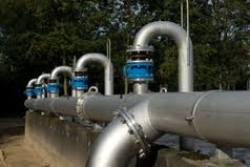Wastewater Processing
Step 1. Preliminary Treatment: Wastewater passes through bar screens, which remove large debris, like plastics, rags and sticks. Next, the wastewater flows to a grit removal area where the heaviest solids — mostly sand and rocks — are removed. The screenings and grit are taken to a local landfill.
Step 2. Primary Treatment: The wastewater flows to primary clarifiers, where solids sink to the bottom and are removed. Solids that float are skimmed away.
Step 3. Secondary Treatment: The water goes to the aeration tanks where tiny microorganisms eat the organic waste materials. Air is continually pumped into the water to keep the microorganisms active.
Step 4. Clarification: The water flows to the secondary clarifiers, where the water is allowed to sit. Final bits of solids sink to the bottom of the tanks and are removed. Floating solids are skimmed off the top and removed.
Step 5. Disinfection: After clarification, the water flows through a chlorine contact chamber where a small amount of chlorine is added to kill any remaining harmful bacteria. Finally, the clean water is released into the river.
Recycling Solid Matter:
The solid matter or sludge that sinks to the bottom of the wastewater treatment tank is sent to the thickening process.
A. During the thickening process, water is removed and the sludge floats and thickens.
B. The sludge is sent to the digester, where it is heated to approximately 100 degrees Fahrenheit for 14 to 30 days. This process breaks down the sludge into bio-solids, water, carbon dioxide and methane gas.
C. The methane gas is used to generate electricity and heat the digester.
D. After the biosolids leave the digester, they are used as a soil amendment. Crews transport these biosolids and apply them to privately owned hay fields. Biosolids contain organic material which improves the "tilth" and adds nutrients to the soil.

